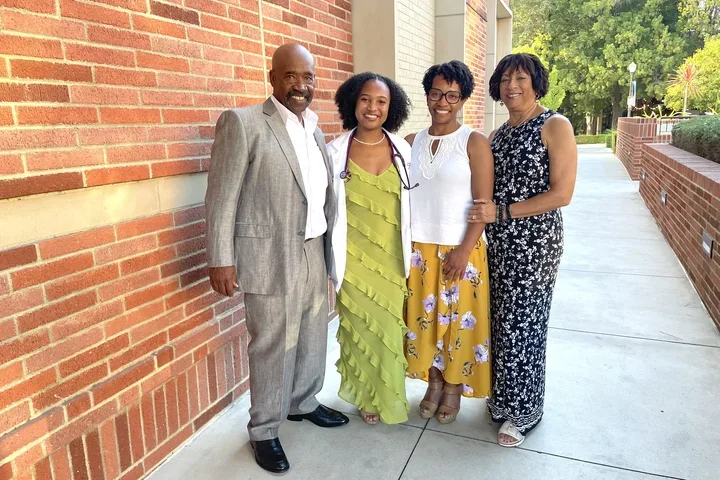The brain cells you haven’t heard about
UCLA’s Baljit Khakh will discuss the long-overlooked role of astrocytes in health and disease during his Faculty Research Lecture on April 19

For years, Baljit Khakh has been studying stars — not those in the firmament but those in our brains. Astrocytes, so named because of their starlike shape, make up around half of our brain cells, but in research they’ve long taken a back seat to neurons.
Khakh’s research is changing that. The professor of physiology and neurobiology still recalls sifting through scientific studies, seeing the progress being made in neuronal research and being struck by how little was known about astrocytes. “The more I read,” he recalled, “the more I became convinced that key questions remained to be tackled.”
To that end, Khakh’s lab has developed new concepts and tools that have helped elucidate the structure, function and distribution of these specialized glial cells across the brain. Thanks in large part to those efforts, it is now known that astrocytes, in a broad sense, act as neurons’ housekeepers, providing them with nutrients and maintaining an optimal chemical environment that enables them to communicate effectively with each other.
But Khakh’s groundbreaking research has also revealed that astrocyte dysfunction plays a crucial role in neurological and psychiatric diseases, from Huntington’s and Alzheimer’s to ADHD and obsessive-compulsive disorder. “Essentially all brain diseases likely contain an astrocytic component,” Khakh said. “The key is to dissect it and exploit it.”
In advance of delivering the 134th Faculty Research on Wednesday, April 19, Khakh spoke with us about his research, his work with high school students from underserved backgrounds and what the future may hold in terms of therapeutics for brain-related disorders.
What inspired you as a young person to study science?
I liked doing experiments and thinking about how things worked, even as a child. And as I grew older, I valued being left alone to do so. Then, when I was an undergraduate, one of my tutors suggested I read “Adventures in Physiology” by Nobel laureate Sir Henry H. Dale. I found that fascinating and decided to do a Ph.D. on the ATP receptors thought to mediate signaling between nerves and between nerves and smooth muscle — it was an idea that, at the time, seemed to challenge Dale’s principle.
Your research has shown that astrocytes play a key role in neuron signaling and other functions. These cells were first identified in 1891, yet they have been ‘understudied’ for quite some time. Why do you think that is?
Neuroscience advanced through the development of tools to study neurons. Often those tools were not ideal to study non-neuronal cells such as astrocytes. This is because unlike neurons, astrocytes are electrically silent. As a result, our understanding of these cells has lagged behind. However, in the last few years, there has been excellent progress, and the use of designer tools is now beginning to reveal the functions of astrocytes in the brain.
Astrocytes appear to play a key role in both neuronal health and dysfunction. What do you foresee as the future of disease-related research involving astrocytes?
Studies of astrocytes in disease have strong implications for the development of new therapies. By highlighting astrocyte pathobiology and how it affects neurons, these studies suggest that treatment approaches that target only neurons are likely to fail.
Those neuronal targets of therapy necessarily reside in an environment that contains astrocytes — as well as other glial cells, both oligodendrocytes and microglia — which are themselves dysfunctional, and hence inadequate in their essential supportive roles during disease.
In broad terms, tackling brain diseases from the standpoint that multicellular disorders may require multimodal therapeutics may hold the greatest promise for advancing novel and effective therapies.
You run a summer program, the UCLA Physiology Outreach Program, that offers science instruction and mentorship to high school students from underserved communities. How did that start, and how is it going?
I started that because there were few opportunities for kids from underserved communities to engage in experimental work in research labs. Therefore, Tom Vondriska, a professor at the David Geffen School of Medicine at UCLA, and I teamed up to start a program that allowed this to happen at UCLA.
The program, which has now been running for 15 years, is doing extremely well, and I know that we could accomplish even more with a boost in financial and administrative support. It would be great to be able to eventually endow the program and expand it across UCLA.
If you could give a message to young scientists, what would it be?
As a Ph.D. student, when I went to my first international scientific conference, in Vienna, Professor Geoffrey Burnstock from University College London, a giant in his field, invited me for a coffee in a Vienna café. As he drank a cappuccino and hacked away at an enormous apple strudel, he looked up at me from beneath his impressive eyebrows and said, “You seem to be doing well. Remember, always stay positive. In science, negative people don’t survive.” I think that is good advice.
What was your reaction to being chosen for the Faculty Research Lecture?
I was happy and honored. Although I am giving the lecture, it is really recognition for the wonderful trainees who have contributed to the success of my lab.
Outside of your research, what do you like to do?
I like going on long walks and hiking with my wife and two dogs.
Original Article: "The brain cells you haven’t heard about"



